高中英语公开课教学设计讲课稿
英语公开课优质教案高中英语优质公开课教案(五篇)
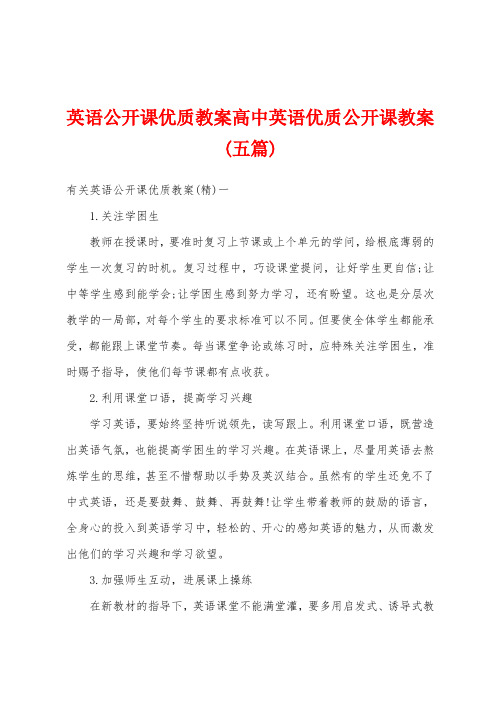
英语公开课优质教案高中英语优质公开课教案(五篇)有关英语公开课优质教案(精)一1.关注学困生教师在授课时,要准时复习上节课或上个单元的学问,给根底薄弱的学生一次复习的时机。
复习过程中,巧设课堂提问,让好学生更自信;让中等学生感到能学会;让学困生感到努力学习,还有盼望。
这也是分层次教学的一局部,对每个学生的要求标准可以不同。
但要使全体学生都能承受,都能跟上课堂节奏。
每当课堂争论或练习时,应特殊关注学困生,准时赐予指导,使他们每节课都有点收获。
2.利用课堂口语,提高学习兴趣学习英语,要始终坚持听说领先,读写跟上。
利用课堂口语,既营造出英语气氛,也能提高学困生的学习兴趣。
在英语课上,尽量用英语去熬炼学生的思维,甚至不惜帮助以手势及英汉结合。
虽然有的学生还免不了中式英语,还是要鼓舞、鼓舞、再鼓舞!让学生带着教师的鼓励的语言,全身心的投入到英语学习中,轻松的、开心的感知英语的魅力,从而激发出他们的学习兴趣和学习欲望。
3.加强师生互动,进展课上操练在新教材的指导下,英语课堂不能满堂灌,要多用启发式、诱导式教学方法。
例如,教授单词时,重点单词和句型应多操练,举出各种典型例句,和生活性强的例句,让学生充分参加。
在反复操练中,兼顾那些学困生,让他们也获得胜利的体验,这样,有效地增加了课堂分散力。
4.增加课前预习和课后复习环节课前预习,对于上课起到很好的促进作用,是打造英语高校课堂不行或缺的环节。
布置可课下作业时,最好分成学习小组,利用早、晚阅读时间,小组长可以起到催促和检查的作用。
固然,课上导入和复习也是检查的重要一环。
学生回答下列问题时,多鼓舞,少批判,给学生留点自尊,也就给他们留下了学习的士气。
总之,只有全班学生融入到英语学习大课堂中,才算是真正的英语高校课堂。
让全部的英语教师为英语高校课堂而努力吧!有关英语公开课优质教案(精)二敬重的大方的漂亮的得意而心地和善的英语教师:你好!在这样一个悲凉的日子里,我怀着内疚的惭愧的心情写下了这封信,不但检讨自己,更是为了渴望你的原谅。
高中英语公开课教案

高中英语优质公开课教案精选一、教学内容本节课选自高中英语教材第二册第四章,主题为“Culture and Communication”。
教学内容详细包括:第一部分,介绍不同文化背景下的交际方式;第二部分,学习英语书信的写作格式及技巧;第三部分,通过实际案例了解跨文化交流中的常见问题及解决办法。
二、教学目标1. 知识与技能:使学生掌握不同文化背景下的交际方式,学会英语书信的写作格式及技巧。
2. 过程与方法:培养学生运用英语进行跨文化交际的能力,提高学生的听说读写综合运用能力。
3. 情感态度与价值观:激发学生对跨文化交流的兴趣,培养学生的跨文化意识。
三、教学难点与重点1. 教学难点:英语书信的写作格式及技巧,跨文化交流中的常见问题及解决办法。
2. 教学重点:不同文化背景下的交际方式,英语书信的写作方法。
四、教具与学具准备1. 教具:多媒体课件,黑板,粉笔。
2. 学具:英语教材,笔记本,文具。
五、教学过程1. 导入:通过展示一组跨文化交际的图片,引发学生对本节课主题的兴趣。
2. 新课内容呈现:详细讲解不同文化背景下的交际方式,引导学生学习英语书信的写作格式及技巧。
3. 实践情景引入:设置一个跨文化交际场景,让学生分组讨论并展示成果。
4. 例题讲解:分析一个英语书信写作的案例,讲解写作技巧及注意事项。
5. 随堂练习:让学生根据所学知识,编写一封英语书信。
六、板书设计1. 板书左侧:列出不同文化背景下的交际方式。
2. 板书右侧:展示英语书信的写作格式及技巧。
3. 板书中央:强调跨文化交流的重要性。
七、作业设计1. 作业题目:以“An Important Cultural Experience”为题,写一篇英语短文,分享一次你认为有意义的跨文化交流经历。
2. 答案示例:In my opinion, an important cultural experience I had was when I visited Japan last summer. I learned about the Japanese tea ceremony and had a chance to participate in it. It was a unique experience that allowed me to appreciate the beauty of Japanese culture.八、课后反思及拓展延伸1. 反思:本节课学生对跨文化交流的兴趣浓厚,课堂参与度高。
高中英语说课稿模板 (2)
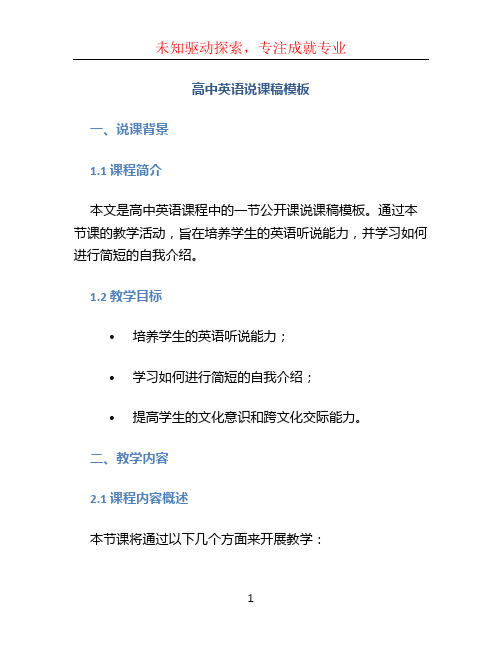
高中英语说课稿模板一、说课背景1.1 课程简介本文是高中英语课程中的一节公开课说课稿模板。
通过本节课的教学活动,旨在培养学生的英语听说能力,并学习如何进行简短的自我介绍。
1.2 教学目标•培养学生的英语听说能力;•学习如何进行简短的自我介绍;•提高学生的文化意识和跨文化交际能力。
二、教学内容2.1 课程内容概述本节课将通过以下几个方面来开展教学:•学生的自我介绍;•指导学生如何进行简短的自我介绍;•阅读一篇关于文化差异的短文,学习文化意识和跨文化交际能力。
2.2 教学重点•学生的自我介绍;•学习如何进行简短的自我介绍。
2.3 教学难点•学生的自我介绍的语言表达;•学习如何进行简短的自我介绍。
三、教学准备3.1 环境准备课堂环境需要安静、整洁、学生容易被聚焦;3.2 物品准备•讲台;•演讲稿;•录音设备。
四、教学过程4.1 导入环节在教学开始前,教师可以进行一些导入活动来激发学生的兴趣和准备学习。
4.2 自我介绍首先,教师可以向学生展示一个简短的自我介绍的范例,并对范例进行解析和分析。
然后,教师可以要求学生轮流进行自我介绍,同时录下学生的自我介绍。
4.3 自我介绍的要点在学生进行自我介绍之后,教师可以对学生的表达进行点评,并指导学生如何进行简短的自我介绍。
教师可以提醒学生注意以下几个要点:1.用简洁明了的语言介绍自己的姓名、年龄和学校等基本信息;2.强调自己的兴趣爱好,介绍自己的优点;3.在介绍过程中注意语音语调和表情动作的适应。
4.4 阅读文化差异短文为了提高学生的文化意识和跨文化交际能力,教师可以选择一篇关于文化差异的短文,让学生进行阅读,并进行讨论。
教师可以引导学生分析文中的文化差异,并与学生分享自己对文化差异的理解和体验。
4.5 练习与实践为了帮助学生巩固所学内容,教师可以设计一些练习和实践活动,让学生在真实的情境中进行实际操作。
例如,教师可以组织学生进行角色扮演,让他们在模拟的情景中进行简短的自我介绍。
高中英语优秀讲课教案模板范文
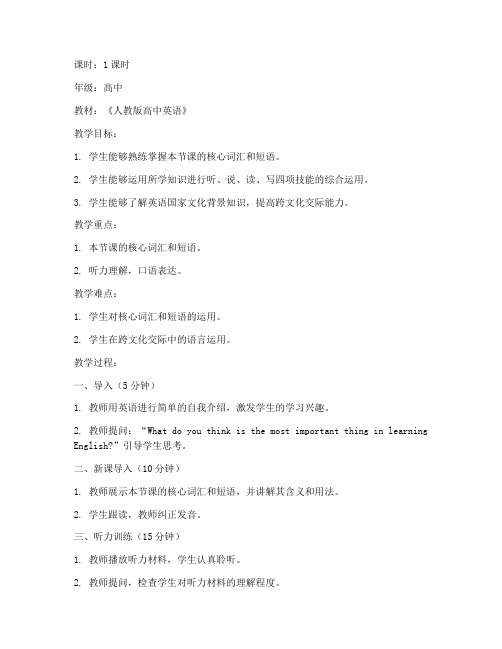
课时:1课时年级:高中教材:《人教版高中英语》教学目标:1. 学生能够熟练掌握本节课的核心词汇和短语。
2. 学生能够运用所学知识进行听、说、读、写四项技能的综合运用。
3. 学生能够了解英语国家文化背景知识,提高跨文化交际能力。
教学重点:1. 本节课的核心词汇和短语。
2. 听力理解,口语表达。
教学难点:1. 学生对核心词汇和短语的运用。
2. 学生在跨文化交际中的语言运用。
教学过程:一、导入(5分钟)1. 教师用英语进行简单的自我介绍,激发学生的学习兴趣。
2. 教师提问:“What do you think is the most important thing in learning English?”引导学生思考。
二、新课导入(10分钟)1. 教师展示本节课的核心词汇和短语,并讲解其含义和用法。
2. 学生跟读,教师纠正发音。
三、听力训练(15分钟)1. 教师播放听力材料,学生认真聆听。
2. 教师提问,检查学生对听力材料的理解程度。
3. 学生复述听力内容,教师点评。
四、口语表达(15分钟)1. 教师设计一个与课文内容相关的场景,让学生进行角色扮演。
2. 学生分组进行口语练习,教师巡视指导。
3. 学生展示练习成果,教师点评。
五、阅读训练(15分钟)1. 教师展示课文,学生阅读。
2. 教师提问,检查学生对课文的理解程度。
3. 学生复述课文内容,教师点评。
六、写作训练(10分钟)1. 教师给出写作题目,学生根据所学知识进行写作。
2. 学生展示写作成果,教师点评。
七、课堂小结(5分钟)1. 教师对本节课所学内容进行总结,强调重点和难点。
2. 学生回顾本节课所学知识,提出疑问。
八、布置作业(5分钟)1. 让学生课后复习本节课所学词汇和短语。
2. 让学生完成一篇与课文内容相关的写作练习。
教学反思:本节课通过多种教学手段,帮助学生掌握了本节课的核心词汇和短语,提高了学生的听、说、读、写四项技能。
在教学过程中,教师应关注学生的个体差异,因材施教,激发学生的学习兴趣,提高教学效果。
高中英语优质公开课教案【优秀范文】

高中英语优质公开课教案【优秀范文】一、教学内容本节课选自高中英语教材第二册第六单元“Science and Technology”,具体内容包括:Text A “The Future of Science and Technology”以及Text B “Innovations Around Us”。
通过本节课的学习,学生将深入了解科技发展的现状与未来,以及创新对生活的影响。
二、教学目标1. 学生能够理解并掌握文章中的重点词汇和短语,了解科技发展的现状与趋势。
2. 学生能够运用目标语言进行口头和书面表达,对科技和创新发表自己的观点。
3. 学生能够培养创新思维,提高观察力和想象力。
三、教学难点与重点教学难点:文章中长难句的理解,科技词汇的掌握,以及创新思维的培养。
教学重点:文章主题思想的把握,目标语言的运用,以及口头和书面表达能力的提高。
四、教具与学具准备教具:多媒体设备、黑板、粉笔学具:课本、笔记本、文具五、教学过程1. 导入:通过展示一组科技发展图片,引发学生对科技现状与未来的思考,激发学习兴趣。
时间:5分钟2. 阅读Text A:学生自主阅读,完成课后练习。
教师针对重点句型和词汇进行讲解。
时间:15分钟3. 小组讨论:学生分组讨论,分享对文章主题和科技发展趋势的看法。
时间:10分钟4. 口头表达:学生运用目标语言,针对科技和创新发表自己的观点。
时间:10分钟5. 阅读Text B:教师引导学生关注生活中的创新实例,培养学生的观察力和想象力。
时间:15分钟6. 随堂练习:学生完成课后练习,巩固所学知识。
时间:10分钟时间:5分钟六、板书设计1. Science and Technology2. 重点词汇:innovation, technology, trend, future, impact, observe, imagine3. 重点句型:It is believed that…, In my opinion,…七、作业设计1. 作业题目:Write an essay on the topic "The Impact of Science and Technology on Our Life".2. 答案要求:不少于100词,运用所学词汇和句型,表达自己的观点。
高中英语公开课教案
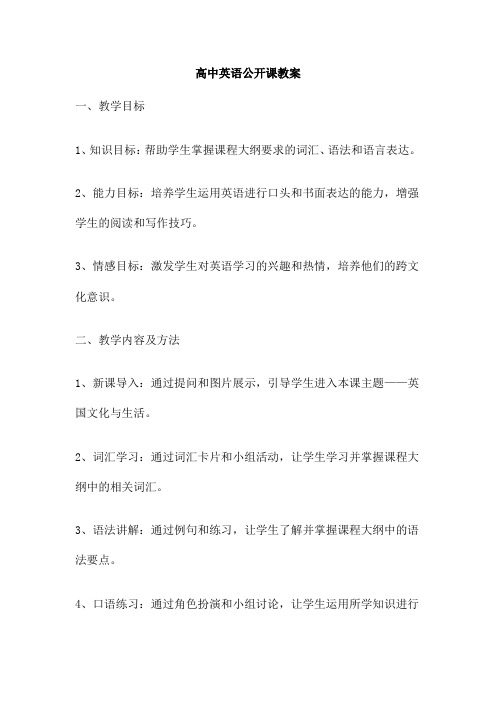
高中英语公开课教案一、教学目标1、知识目标:帮助学生掌握课程大纲要求的词汇、语法和语言表达。
2、能力目标:培养学生运用英语进行口头和书面表达的能力,增强学生的阅读和写作技巧。
3、情感目标:激发学生对英语学习的兴趣和热情,培养他们的跨文化意识。
二、教学内容及方法1、新课导入:通过提问和图片展示,引导学生进入本课主题——英国文化与生活。
2、词汇学习:通过词汇卡片和小组活动,让学生学习并掌握课程大纲中的相关词汇。
3、语法讲解:通过例句和练习,让学生了解并掌握课程大纲中的语法要点。
4、口语练习:通过角色扮演和小组讨论,让学生运用所学知识进行口头表达。
5、阅读理解:通过阅读文章并回答问题,提高学生的阅读理解能力。
6、写作训练:通过写小作文,让学生掌握课程大纲要求的写作技巧。
7、课堂小结:回顾本课所学内容,再次强调重点和难点。
三、教学评价与反馈1、课堂表现:观察学生在课堂上的参与度、表现和反应。
2、练习及作业:检查学生的练习和作业完成情况,评估学生的学习效果。
3、学生自评和互评:引导学生对自己的学习进行评价,同时鼓励他们相互评价。
4、教师评价:根据学生的表现和反馈,对教学方法和内容进行调整和改进。
四、教学反思与改进1、对本节课的教学内容进行反思,分析哪些方法有效,哪些需要改进。
2、对学生的学习情况进行反思,了解哪些学生掌握了所学内容,哪些需要加强辅导。
3、根据反思结果,对教学方法和内容进行改进,以提高教学质量。
高中英语公开课教案一、教学目标1、知识目标:通过本次公开课,使学生掌握一定的英语词汇和语法知识,能够理解并运用相关的语言表达方式。
2、能力目标:培养学生的英语听说读写能力,提高学生的英语语言运用能力。
3、情感态度与价值观目标:培养学生对英语学习的兴趣和热情,增强学生的自信心和积极性,培养学生的团队合作精神和自主学习能力。
二、教学内容1、词汇:学习并掌握与主题相关的常用词汇。
2、语法:学习并掌握与主题相关的基本语法知识。
高中英语说课稿范文优秀5篇
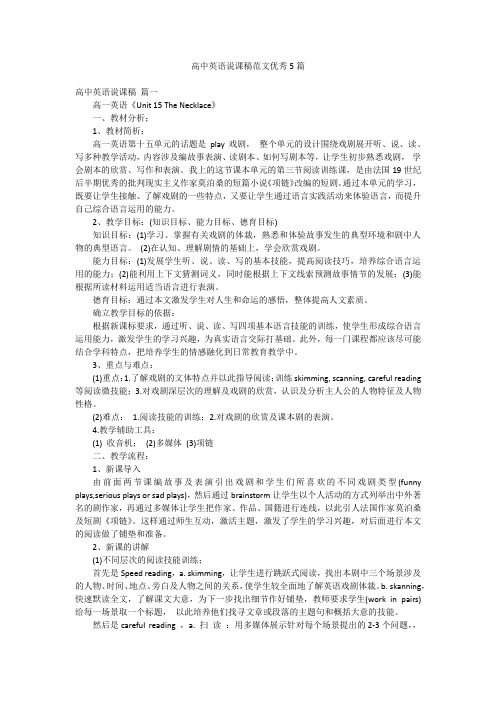
高中英语说课稿范文优秀5篇高中英语说课稿篇一高一英语《Unit 15 The Necklace》一、教材分析;1、教材简析:高一英语第十五单元的话题是play戏剧,整个单元的设计围绕戏剧展开听、说、读、写多种教学活动,内容涉及编故事表演、读剧本、如何写剧本等,让学生初步熟悉戏剧,学会剧本的欣赏、写作和表演。
我上的这节课本单元的第三节阅读训练课,是由法国19世纪后半期优秀的批判现实主义作家莫泊桑的短篇小说《项链》改编的短剧。
通过本单元的学习,既要让学生接触、了解戏剧的一些特点,又要让学生通过语言实践活动来体验语言,而提升自己综合语言运用的能力。
2、教学目标:(知识目标、能力目标、德育目标)知识目标:(1)学习、掌握有关戏剧的体裁,熟悉和体验故事发生的典型环境和剧中人物的典型语言。
(2)在认知、理解剧情的基础上,学会欣赏戏剧。
能力目标:(1)发展学生听、说、读、写的基本技能,提高阅读技巧,培养综合语言运用的能力;(2)能利用上下文猜测词义,同时能根据上下文线索预测故事情节的发展;(3)能根据所读材料运用适当语言进行表演。
德育目标:通过本文激发学生对人生和命运的感悟,整体提高人文素质。
确立教学目标的依据:根据新课标要求,通过听、说、读、写四项基本语言技能的训练,使学生形成综合语言运用能力,激发学生的学习兴趣,为真实语言交际打基础。
此外,每一门课程都应该尽可能结合学科特点,把培养学生的情感融化到日常教育教学中。
3、重点与难点:(1)重点:1.了解戏剧的文体特点并以此指导阅读;训练skimming, scanning, careful reading 等阅读微技能;3.对戏剧深层次的理解及戏剧的欣赏,认识及分析主人公的人物特征及人物性格。
(2)难点:1.阅读技能的训练;2.对戏剧的欣赏及课本剧的表演。
4.教学辅助工具:(1) 收音机;(2)多媒体(3)项链二、教学流程:1、新课导入由前面两节课编故事及表演引出戏剧和学生们所喜欢的不同戏剧类型(funny plays,serious plays or sad plays),然后通过brainstorm让学生以个人活动的方式列举出中外著名的剧作家,再通过多媒体让学生把作家、作品、国籍进行连线,以此引人法国作家莫泊桑及短剧《项链》。
高中英语说课稿的范文3篇
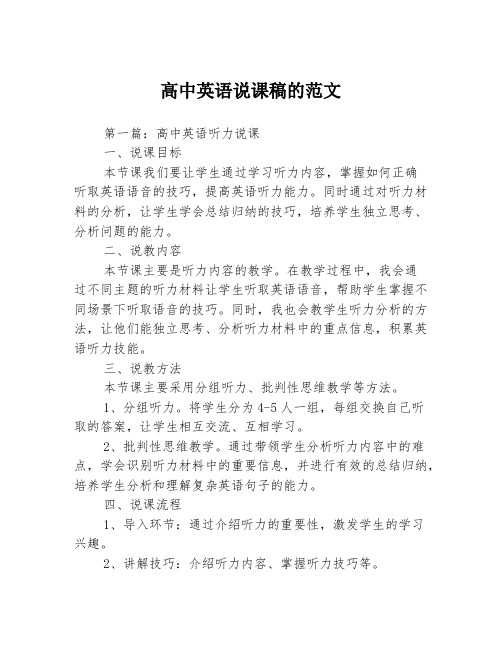
高中英语说课稿的范文第一篇:高中英语听力说课一、说课目标本节课我们要让学生通过学习听力内容,掌握如何正确听取英语语音的技巧,提高英语听力能力。
同时通过对听力材料的分析,让学生学会总结归纳的技巧,培养学生独立思考、分析问题的能力。
二、说教内容本节课主要是听力内容的教学。
在教学过程中,我会通过不同主题的听力材料让学生听取英语语音,帮助学生掌握不同场景下听取语音的技巧。
同时,我也会教学生听力分析的方法,让他们能独立思考、分析听力材料中的重点信息,积累英语听力技能。
三、说教方法本节课主要采用分组听力、批判性思维教学等方法。
1、分组听力。
将学生分为4-5人一组,每组交换自己听取的答案,让学生相互交流、互相学习。
2、批判性思维教学。
通过带领学生分析听力内容中的难点,学会识别听力材料中的重要信息,并进行有效的总结归纳,培养学生分析和理解复杂英语句子的能力。
四、说课流程1、导入环节:通过介绍听力的重要性,激发学生的学习兴趣。
2、讲解技巧:介绍听力内容、掌握听力技巧等。
3、分组听力:让学生进行分组听力。
4、批判性思维教学:通过带领学生分析听力内容中的难点,学会识别听力材料中的重要信息,并进行有效的总结归纳,培养学生分析和理解复杂英语句子的能力。
5、总结巩固:通过总结教学内容,帮助学生深化英语听力技能。
五、说教体会本节课主要是针对英语听力技能进行教学,通过讲解技巧、分组听力等具体手段,情于激发学生的英语学习兴趣,提高学生的英语听力能力。
同时,本课程也通过批判性思维教学,帮助学生深度理解听力材料中的难点,培养学生分析和总结归纳的能力。
教师应注意在教学中注重不同层次学生的教学差异,针对学生存在的问题进行及时的分析和解决,确保教学效果最大化。
人教版高中英语公开课教案

人教版高中英语公开课教案人教版高中英语公开课教案1教学准备教学目标1. 通过学生分享自身的旅游经历,用英语进行交流与表达。
2. 通过略读与找读,使学生获取文章主要信息,练习阅读技巧。
3. 通过小组讨论为旅游准备的物品,使学生用英语简单的语言实践活动。
教学重难点教学重点:利用阅读技巧,获取文章大意及细节教学难点:用英语交流并进行简单实践活动—旅游需要准备的物品教学过程I、Warming Up:1. I’d like to share my travelling experience with you, and would you like to share your travelling experience?2. The world has many great rivers. Have you been to these rivers?设计意图:大部分学生都喜欢旅游,老师谈谈自身旅游的经历,询问学生的旅游经历。
列举世界上的河流图片,让学生来欣赏认识美好的河流。
能有效地调动学生的学习积极性。
河流图片的展示,学生猜测河流的名字,唤起学生的学习兴趣以及对大自然的热爱。
II. Pre-readingHave you been to the Mekong River? What countries does the Mekong River flow through?设计意图:展示沿湄公河的地图,引起学生的兴趣,让学生观察地图,说出湄公河流经的国家,为随后的阅读做好了内容和词汇上的铺垫。
III. Reading1. SkimmingSkim the passage and find the main idea for each paragraphPara 1: DreamPara 2: A stubborn sisterPara 3: Preparation设计意图:略读:学生快速浏览课文,寻找相关信息并搭配段落大意。
高中英语公开课教案模板

课程名称:高中英语语法教学——现在进行时授课年级:高中一年级授课时间: 45分钟教学目标:1. 知识目标:学生能够理解现在进行时的概念和用法,并能正确运用现在进行时态描述正在进行的动作或状态。
2. 技能目标:学生能够通过听、说、读、写等活动,提高运用现在进行时进行交流的能力。
3. 情感目标:激发学生对英语学习的兴趣,培养良好的学习习惯和团队合作精神。
教学重点:1. 现在进行时的构成:be + 现在分词2. 现在进行时的用法:描述正在进行的动作或状态教学难点:1. 现在进行时与一般现在时的区别2. 现在进行时在不同语境中的运用教学准备:1. 课件:包括语法讲解、例句、练习题等2. 听力材料:与现在进行时相关的听力材料3. 教学工具:白板、黑板、粉笔等教学过程:一、导入(5分钟)1. 利用图片或视频展示日常生活中正在进行的动作,如:学生上课、老师讲课、人们购物等。
2. 提问:这些动作是什么时态?引导学生思考现在进行时的概念。
二、新课讲解(15分钟)1. 介绍现在进行时的构成:be + 现在分词2. 通过例句讲解现在进行时的用法,如:- I am reading a book.- She is eating breakfast.- They are playing football.3. 比较现在进行时与一般现在时的区别,如:- 一般现在时表示经常性的动作或状态,现在进行时表示正在进行的动作或状态。
- 一般现在时用is/are,现在进行时用am/is/are。
三、练习巩固(15分钟)1. 语法练习:完成练习题,巩固现在进行时的构成和用法。
2. 听力练习:听录音,判断句子是否使用了现在进行时。
3. 口语练习:分组讨论,用现在进行时描述正在进行的动作或状态。
四、总结与拓展(5分钟)1. 总结现在进行时的概念、用法和注意事项。
2. 鼓励学生在日常生活中多运用现在进行时进行交流。
3. 布置作业:收集生活中正在进行的动作的图片或视频,并用现在进行时描述。
外研版高中英语必修一《My First Day at Senior High》优质课公开课课件、教案
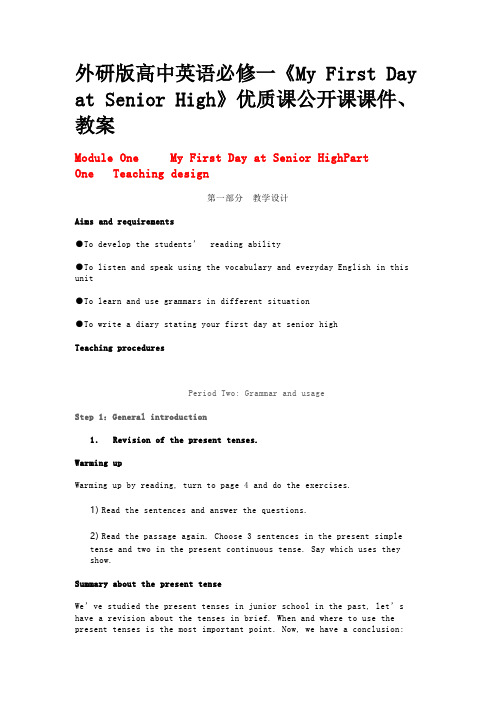
外研版高中英语必修一《My First Day at Senior High》优质课公开课课件、教案Module One My First Day at Senior HighPartOne Teaching design第一部分教学设计Aims and requirements●To develop the students’reading ability●To listen and speak using the vocabulary and everyday English in this unit●To learn and use grammars in different situation●To write a diary stating your first day at senior highTeaching proceduresPeriod Two: Grammar and usageStep 1:General introduction1.Revision of the present tenses.Warming upWarming up by reading, turn to page 4 and do the exercises.1) Read the sentences and answer the questions.2) Read the passage again. Choose 3 sentences in the present simpletense and two in the present continuous tense. Say which uses theyshow.Summary about the present tenseWe’ve studied the present tenses in junior school in the past, let’s have a revision about the tenses in brief. When and where to use the present tenses is the most important point. Now, we have a conclusion:1) To denote present habitual action (表示现在习惯性行为)We go to school at seven o’clock every day.Bill often drinks heavily every night.2) To denote present state. (表示目前存在的状态)Honesty is the best policy to solve problems.Water consists of hydrogen and oxygen.3) To denote an objective truth.(表示客观真理)The earth is round and moves around the sun.Knowledge is power.4) To denote future actions sometimes.(有时指将来)I’ll let you know as soon as I hear from her.The plane leaves for Miami at eight o’clock tonight.The NMET tests (相关高考题):1) The house could fall down soon if no one ____ some quick repairworks.(2004)A. has doneB. is doingC. doesD. had done2) Come and see me whenever ____. (2003 北京)A. you are convenientB. you will be convenientC. it is convenient to youD. it will be convenient toyou3) He will have learned English for eight years by the time he ____from the university next year. (2002 上海)A. will graduateB. will havegraduatedC. graduatesD. is tograduate4) I ____ ping-pong quite well, but I haven’t had time to play sincethe new year. (NMET 2001)A. will playB. have playedC. playedD. play5) –-You are drinking too much.--Only at home. No one ____ me but you. (2000 北京)A. is seeingB. had seenC. seesD. saw( Keys: 1. C, 2. C, 3. C, 4. D 5. C )2. Adjectives ending in –ing and –edWarming up1) Warming up by reading My First Day at Senior High again andunderline theadjectives with –ing or –ed endings.2) Warming up by choosingA. The –ing form describes characteristics of thingsB. The –ed form describes the characteristics of peopleC. The –ing form describes the people or things that cause thefeelingD. The –ed form tells us how people feel( Keys: A B D )Summary about the usage of –ing and–ed.You may see the –ing or –ed forms of verbs from time to time in our reading materials used as adjectives as predicative to express the characteristics of something or somebody, but do you know which verbs they are? Now let’s have a selection:Their regulation in usage can be shown in following patterns:sb. + be + -ed (the –ed form describes people)sth. + be + -ing(the –ing form describes things)The NMET tests(相关高考题):I used to play ping-pong a lot in my spare time, but now I’m interesting in football. (1997 correcting test)(Key:interesting → interested)Step2: Exercises for consolidation1. Exercises for the present tense1.I ____ to have another try if I can get another chance.A. have been meaningB. meanC. am meaningD. meant2. ____ your broken leg.A. Do be careful ofB. Do care forC. Be carefulD. To be care full to3. It’s the third time that you ____ late for school this week.A. wereB. areC. had beenD. have been4. I won’t go home until I ____ the job.A. have doneB. had doneC. have beenD. are5. These kinds of shoes ____ well.A. don’t sellB. are not sellC. won’t be soldD. were not sold6. A quarrel ____ between the two neighbors.A. broke outB. was broken outC. is breaking outD. is broken out7. How long do you think the meeting ____ ?A. lastsB. will lastC. is lastedD. is lasting8. Our school yard ___ an area of 1,500 square meters.A. coversB. is coveredC. extendsD. is extended9. While this tough meat is being cooked, more water should ____ it.A. add toB. be added toC. had been added up toD. will be added to10. They left for Beijing last week and we ____ them so far.A. don’t hear fromB. didn’t hear fromC. haven’t heard fromD. won’t hear from11. You are very busy. I ____ you ____ hard for your experiment.A. suppose, are workingB. am supposing, are workingC. am supposing, workD. suppose, work12. My brother ____ a lot. He ____ a new novel at the moment.A. reads, readsB. reads, is readingC. is reading, is readingD. is reading, read13. Perhaps it will be a long time ____ from abroad.A. when Tom comes backB. when Tom will come backC. before Tome comes backD. that Tom comes back14. There ____ the bus. Harry up.A. is comingB. comeC. comesD. had come15. If you ____ over there for a moment, the manager will be here soon.A. will waitB. waitC. are waitingD. will be waiting( Keys: 1-5 BADAA 6-10 ABABC 11-15 ABCCA )2. Exercises for the participlesTranslate the following into English by using the–ing or –ed forms of verbs. They are used not only as predictive but also as complements of object, but the regulation is similar.1) 你讲的这个事情很有意思。
英语公开课优质教案大全3篇 高中英语优质公开课教案

英语公开课优质教案大全3篇高中英语优质公开课教案下面是分享的英语公开课优质教案大全3篇高中英语优质公开课教案,以供参考。
英语公开课优质教案大全1教学目标:1. 语言知识目标:Words—复习有关animals的单词。
学习新单词:hen, sheep, cow, horse, goat, lamb以及复数的表达方式。
Sentences—熟练掌握下列句子,并能熟练运用。
What are they? They are goats.Are they…? Yes, they are. No, they aren’t.能听写指示语,并做出相应的动作,如:Milk a cow.2. 情感、文化目标:(1)在教学过程中培养学生学习兴趣,帮助他们树立信心。
(2)使学生能掌握以得体的方式与人交际。
一、教学重点、难点:教学重点是掌握农场上常见的牲畜的名称。
教学难点是“horse”与“house”的发音区别,掌握”lamb”的发音以及复数形式的表达。
二、课前准备:1.PC复读机课文MP3格式。
2.教师准备单词卡片:hen, cow, horse, goat, lamb,sheep.和复数图。
三、教学步骤:1. Greeting.2.音标组合操练(一)(1) 播放PC 复读机播放sheep请两位同学上来写听到单词的音标其余同学在下面写[∫i:t ] 分析音标后根据发音规则写出单词sheep sh /∫/ ee /i:/P /p/ 学生拼写单词。
模仿跟读PC复读机手势加音标出示卡片绵羊(2) 播放PC复读机播放horse请两位同学上来写听到单词的音标其余同学在下面写[h):s ] 根据发音规则写出单词horse h / h / or / / s / s /学生拼写单词。
模仿跟读复读机出示卡片马用相同的办法学习hen cow lamb goat单词学习结束听写句子What are they ?They are goats .展示复数图片分别教其它的复数形式(二)。
高中英语优质公开课精品教案【优秀范文】

高中英语优质公开课精品教案【优秀范文】一、教学内容本节课选自高中英语教材第二册第七单元《The Internet》,具体内容包括Chapter 3 "The Impact of the Internet on Our Lives"的Sections 13。
详细内容围绕互联网对日常生活、学习和工作的影响,探讨网络利与弊,分析网络安全问题,以及介绍网络时代的新趋势。
二、教学目标1. 知识目标:学生能掌握与互联网相关的词汇、短语,学会用英语描述互联网对生活各方面的影响。
2. 技能目标:学生能运用所学知识进行讨论、辩论,提高口语表达和听力理解能力。
3. 情感目标:培养学生正确使用互联网的意识,增强网络安全防范意识。
三、教学难点与重点1. 教学难点:如何让学生运用所学知识进行深入讨论,表达自己的观点。
2. 教学重点:掌握与互联网相关的词汇、短语,学会用英语讨论互联网的影响。
四、教具与学具准备1. 教具:多媒体教学设备、黑板、粉笔。
2. 学具:课本、笔记本、字典。
五、教学过程1. 导入:通过展示互联网发展历程的图片,引导学生回顾互联网的发展,引出本节课的话题。
2. 新课内容展示:讲解Chapter 3 "The Impact of the Internet on Our Lives"的Sections 13,穿插讲解词汇、短语,引导学生关注互联网的影响。
3. 实践情景引入:邀请学生分享生活中互联网对他们的影响,进行小组讨论。
4. 例题讲解:针对Section 3中的练习题,进行讲解,帮助学生巩固所学知识。
5. 随堂练习:让学生根据所学内容,完成课后练习题,及时巩固所学知识。
六、板书设计1. The Impact of the Internet on Our Lives2. 词汇、短语:与互联网相关的词汇、短语,如:cybersecurity、online shopping、social media等。
新高中英语课说课稿范文精选17篇

高中英语课说课稿范文精选17篇5高中英语课说课稿范文第一篇Good morning, ladies and gentleman. Today, I feel honored to have the chance to share my ideas about how to teach reading.In the reading process, I will focus on students’ long-term development and enable them to use proper reading skills and strategies. In other words, students are guided to read efficiently and independently.My teaching plan will include 3 sections. They’re analysis of the reading material, identifying the teaching aims and teaching procedures.This period is from unit 6 of book 5 PEP senior high school .thisunit is around the space exploration to improve ss listening speaking reading writing ability ,this period is a listening and speaking ,the topic is hot ,but it is far away from actual life. So the teacher should enlighten the students to think deeply the advantage and disadvantage of space exploration . .According to the new curriculum standard and the characteristic of listening and speaking lesson ,combining the content ,I set up the teaching aimsThrough the listening practice and speaking practice ,improve the ability of using language, know much about the space exploration ,and cultivate the students exploration spirit .So the key point and difficult points is understanding the main idea of the passage .Analysis of the studentsStudents have certain ability and skill in listeningcomprehension ,they have the ability of gaining the information. Have grasped many of the students can express themselves correctly .It is the listening and speaking lesson ,so I will take lingual method and task-based language method ,the students will finish the task in groups and improve the ability of using the language .My teaching procedures if following:Step 1 lead inTo arouse students interest in space exploration ,I show them some pictures about space exploration,the picture of the three famous astronauts in china ,some pictures of look at and try to recognize the peopleStep 2 listening practiceTo draw students attention to the topic, ask students a question and comment on their answer "can you guess what are going to listen to today ?Then to cultivate their ability to grasp the main idea ,let the students listen to the tape ,try to figure out the main idea and do the exercisesPlay the tape for the first time and get the main idea and finish some of the exercisesTo train their ability of searching for detailed information in listening ,I play the tape for the second time and ask them to finish all the exercise and check the answerTo make sure that students can complete the task and offer help if necessary ,play the tape again .At the same time,check the answer with the whole class ,and get them to know how to find the answer by asking "how do you know thatStep 3 speaking activitiesTo have students practise their speaking ability .I ask students to discuss the question in groups from the passage ,we can know that space exploration is developing rapidly in recent years ,do you think ti worth exploring the space ."try to express their own opinion and give us your reasons "why you are for or against the exploration"To check the results of discussion,ask the students to report after ten minutes discussion.To design their impression of different ideas and prepare them for the writing task after class,ask the students to make a list on the blackboardStep 4 conclusionTo enable students to summarize what they have learned ,ask students to sum up the ideas on the blackboardStep 5 assignmentTo enable students to consolidate their knowledge in the form of writing ,ask students to write a passage on whether the space is worth exploring高中英语课说课稿范文第二篇Good morning, everyone! I’m glad to be here to give my lesson plan presentation. The lesson plan I am going to talk about is the reading part of Unit 4 Wildlife Prot ection in the book NSEFC BOOK1. Now I’ll explain my lesson plan from the following aspects——analysis of teaching material, learning condition, teaching objectives, important and difficult points, teaching methods, teaching procure and blackboard design.Analysis of teaching material and learning conditionFirst, let’s come to the analysis of teaching material. The reading material is entitled How Daisy Learned to Help Wildlife. It talks about how Daisy learned the importance of wildlife protection through her communication with some animals in her dream. It is closely connected with this unit’s topic——the importance of wildlife protection. The passage is clearly organized by Daisy’s 3 trips in which she communicates with several endangered animals, and there are not so much new words in this passageNow let’s move on to the analysis of learning condition, students must be very familiar with the topic and interested in all kinds of animals. Students have acquired the basic reading skills, such as skimming, scanning, etc to deal with different reading tasks, and they can do some discussion in English. However, they are notfamiliar with the organization WWF mentioned in the passage, not clear with the author’s purposes of writing some sentences, and they may find it difficult to deal with some real problems by themselves concerning with wildlife protection.Teaching objectivesBased on the analyses of the teaching material and the learning condition, I will show you the teaching objectives.(1) Language Skills:1. Students can get the needed information about Daisy’s trip by applying different reading skills.2. Students can summarize the main ideas of each paragraph through skimming.3. Students can analyze the author’s purpose of writing sentences like “No rainforest, no animals, no drugs” and “And there are always WWF.”(2) Language Knowledge:1. Students can know more about why some animals are in danger and how to protect them.2. Students can know how to use the new words, such as mercy, importance, contain, etc.(3) Affective objectives:Students can realize the importance of wildlife protection.(4) Culture awareness:Students can know something about the organization WWF.(5) Learning strategy:1. Students can improve their communication strategy by discussing with classmates about protecting animals.2. Students can refer to the Internet to know more about wildlife protection.Key point and difficult points:Key points:(1) Students can improve their reading skills, such as summarizing, skimming, scanning, etc.(2)Students can get the main idea of the passage.(3) Students can know how to use the new words in the passage.Difficult Points:1. Students can summarize the main ideas of each paragraph.2. Students can get the implied meaning of some sentences in the passage.Teaching methodsAs for teaching methods, I’ll follow the interactive model to deal with the reading material and communicative approach to put what the students have learned into use.Teaching procedure:Then I’ll talk about the most important part of my presentation——teaching procedure.Warming-upThe first step is warming-up. It will cost 3 minutes. First, I’ll show my students a short clip of video about the endangered wildlife. Then, I’ll ask the students to name the endangered animals in i t together with me and list more. This step is aimed to arise the students’ interest and get the students familiar with the topic——wildlife.Pre-readingThe second step is pre-reading. It will cost about 5 minutes with 2 activities. In the first activity, I’ll introduce something about the organization WWF to the students. The second activity is to ask students to give their reasons to the question “Why are some animals in danger?”. The purpose of these activities is to let students have the background knowledge of the passage and get interested in reading the passage. And it is also in this step some new words like fur, protect, affect will be taught.While-readingThe third step is while-reading. It consists of 3 activities which will be finished in 20 minutes.The first activity is skimming. It will cost about 5 minutes. I’ll ask the students to skim the passage and work out the main ideas of each paragraph by themselves. It is the difficult point for the students, so I’ll give them hints such as key words or some answers to choose when necessary to help them to do the summarization. Thepurpose is the improve students’ reading ability——skimming and let them get the main ideas of the passage.The second activity is scanning. It will cost about 3 minutes. I’ll ask the students to read fast and do some True or False questions. The purpose of it is to get students know the detailed information about Daisy’s trip and wildlife protection and improve their scanning ability.The third activity is close reading. It will cost about 12 minutes. Students will be asked to read the passage paragraph by paragraph and fill in the form the needed information——name of the animals in Daisy’s trips, their situation, and result. Then I’ll ask the students questions: “What does t he author want to tell us from the first paragraph?”, “How the government help protect the elephants?”, and “How do you understand the sentences ‘No rainforest, no animals, no drugs.’ and ‘and there was always WWF.’?”. These 3 questions involve some implie d meanings which may be difficult for students to work out, so I’ll give some key words as hints for them or ask some other related questions to guide them to work out the answers. The purpose of this activity is to make the students fully understand the reading material and try to analyze the author’s purpose of writing some sentences. And in these 3 activities, I can also teach students some new words like carpet, respond, powerful, etc.Post-readingThe fourth step is post-reading. It will cost about 10 minutes. I’ll ask the students to form groups of 4 and do the discussion based on the questions on page 27, and they can refer to the reading material to work out these answers. After the discussion, I’ll ask some students to report their answers, especially how to protect the endangered animals.HomeworkThe last step is homework. It will take about 2 minutes. The homework is to write a short passage entitled “How to Protect Wildlife”. They can surf the internet and try to find more ways about wildlife protection.Well, this is the blackboard design. In the middle, it’s the formfor students to fill in, and on the 2 sides, there are the new wordsin the passage. Some of them, as I’ve mentioned, are taught in pre-reading. Most of them is taught in third-step while-reading.That’s all for my lesson plan presentation. Thank you for your attention. Thank you!Unit 4 How Daisy Learned to Help Wildlifeprotect Animal Situation Result carpetfur Para 1 antelope being hunt decrease powerfulaffect Para 2 respondin relief Para 3 importancemosquitoes appreciate高中英语课说课稿范文第三篇Good morning, ladies and gentlemen . I’m xx. I’m from xx High School. Today, I feel honored to have the chance to share my ideas with you. In the reading process, I will focus on students’ long –term development and enable them to use reading strategies to read efficiently and independently.My teaching plan will include 4 sections. They’re analysis of the teaching material,. Teaching aims , teaching methods and teaching procedures.Section1 . Analysis of the teaching material.The selected teaching material is a magazine aritcle taken from the reading of Module 2 , Unit3 . It is about the curse of themummy ,which deals with an amazing man who devoted most of his time making discoveries in Egypt and strange things that happened after his finding the tomb of king Tutankhamun.Section 2 Identifying the teaching aims.Based on the analysis of the teaching material, I have chosen the following as the teaching aims,The 1st aim: Train the students’ reading ability reading skills- predicting information.The 2nd aim: Learn some useful words and expressions.The 3rd aim: Develop the students’ creative, comprehensive and consolidating abilities.Section3 Teaching methods and aids.1. Enjoyment of a short film before reading to make the students interested in what they’ll learn.2. Fast reading to get the general idea of the text.3. Careful reading to answer some detailed questions4. Multi-mediaSection4 Teaching procedures.Part1 Lead-inHelp the students to recall the well –known film TITANNIC by showing them a short flash of the film. The purpose of this activity is to arouse the students’ interest and curiosity to read the passage. (on the screen )Part 2 Reading comprehension- fast reading and careful reading1. Reading strategy – predicting information in advance.Before asking the students to skim the passage, direct theirattention to reading strategy first. Conduct the activity as follows .(on the screen)2. SkimmingAsk the students to skim the passage and complete the three questions of Part A on page 42.3. Reread the passageAsk the students to reread the passage and identify which statements are true and which are false. Have the students complete Part C1 individually. Check the answer as a class. Statements in Part C2 are summaries of the paragraphs. Ask the students to match the statements with the paragraphs. Check the answer as a class.4. Listening for detailed informationEvaluate the students’ comprehension by asking them to identify the relationships between these characters. (on the screen)5. structure readingAsk the students to divide the text into a few parts according to the general idea of each paragraph .(on the screen)According to the diagram,I let the students make a summary of the text or let students fill in the blanks .(on the screen)Part 3 ConsolidationAsk the students to complete Part D and E individually . I can adapt Part D as the example shows . After completing Part D, the students are required to read the article in Part E and then fill in the missing words, check the exercises as a class.Part 4 Post –reading activities1. Ask the students to express their opinions on the following questions .(on the screen)2. Ask the students to write a summary about Howard Carter.3. Ask the students to focus on Part F and make up a dialogue as the example show. Make sure that all the students participate in the discussion.Ok , So much for my teaching plan ,Thank you for your careful attention.高中英语课说课稿范文第四篇新课程标准的三维教学观,具体到英语学科就是要整合发展学生语言技能、语言知识、情感态度、学习策略和文化意识五个方面的素养,培养学生综合运用语言的能力。
高中英语说课稿范文最新6篇
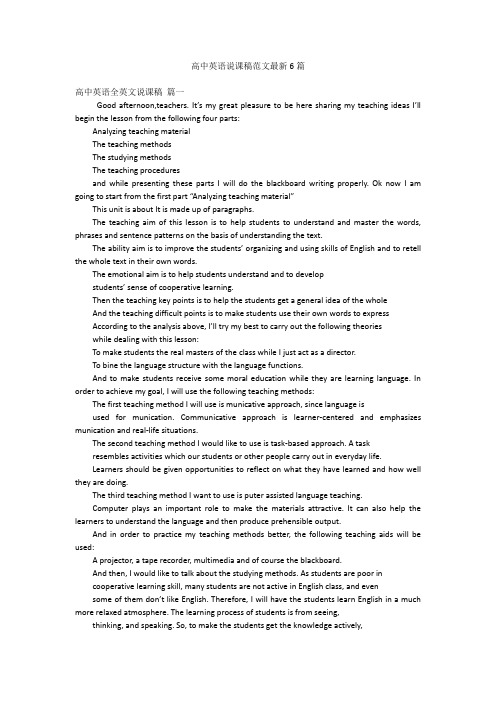
高中英语说课稿范文最新6篇高中英语全英文说课稿篇一Good afternoon,teachers. It’s my great pleasure to be here sharing my teaching ideas I’ll begin the lesson from the following four parts:Analyzing teaching materialThe teaching methodsThe studying methodsThe teaching proceduresand while presenting these parts I will do the blackboard writing properly. Ok now I am going to start from the first part “Analyzing teaching material”This unit is about It is made up of paragraphs.The teaching aim of this lesson is to help students to understand and master the words, phrases and sentence patterns on the basis of understanding the text.The ability aim is to improve the students’ organizing and using skills of English and to retell the whole text in their own words.The emotional aim is to help students understand and to developstudents’ sense of cooperative learning.Then the teaching key points is to help the students get a general idea of the wholeAnd the teaching difficult points is to make students use their own words to expressAccording to the analysis above, I’ll try my best to carry out the following theorieswhile dealing with this lesson:To make students the real masters of the class while I just act as a director.To bine the language structure with the language functions.And to make students receive some moral education while they are learning language. In order to achieve my goal, I will use the following teaching methods:The first teaching method I will use is municative approach, since language isused for munication. Communicative approach is learner-centered and emphasizes munication and real-life situations.The second teaching method I would like to use is task-based approach. A taskresembles activities which our students or other people carry out in everyday life.Learners should be given opportunities to reflect on what they have learned and how well they are doing.The third teaching method I want to use is puter assisted language teaching.Computer plays an important role to make the materials attractive. It can also help the learners to understand the language and then produce prehensible output.And in order to practice my teaching methods better, the following teaching aids will be used:A projector, a tape recorder, multimedia and of course the blackboard.And then, I would like to talk about the studying methods. As students are poor incooperative learning skill, many students are not active in English class, and evensome of them don’t like English. Therefore, I will have the students learn English in a much more relaxed atmosphere. The learning process of students is from seeing,thinking, and speaking. So, to make the students get the knowledge actively,cooperative learning and task-based learning will be used.Next, I will talk about the teaching procedure. To train the students’ ability of listening, speaking, reading and writing, I have designed the following steps.Step 1 Lead-inAt the very beginning of the class, I will make the students have a free talk about and then discuss the questions in pre-reading on page . The purpose of this step is to arouse the students’ learning interest. After a discussion about the questions,the students will be eager to know something about and it’s the very time to naturally lead the class intoStep 2 Listening prehensionsIn this step, I will write several questions before listening to the text:And then I will make the students answer the questions after listening to the tape. The purpose of this step is to train and improve the students’ listening ability .Step 3 skimming and scanningIn this step, I will give the students two tasks . The first task is to get the general idea, the task is to develop the students’ reading skill by making prediction and to encourage the students to express their own thoughts in English. The second task is to get the main idea of each paragraph. I will divide the whole class into several groups to skim the whole text and get the main idea of each paragraph. The purpose of this task is to improve the students’ fast reading skill and cooperate with each other.And then guide Ss to read the material carefully and take some important notes, then answer the following questions in P.Step 4 Retelling the passageLanguage is learned by municating. It’s my job to creat an atmosphere for students to use the language. The students discuss in their group and then choose a reporter to share to the whole class.Step 7 ConsolidationIn this activity, I will ask some students to read each paragraph, and then do the exercise following the text.Step 8 make a summaryI will go through the important points and difficult points of this lesson with the students once again. And of course, the language points on the blackboard will be mentioned as well.And now let’s move to the last stepStep 9 Homework1. Read the passage as frequently as you can2. Find out some words and sentences you think are beautiful and recite them.Purpose of my design: Homework is so important and necessary for to master the knowledge they learned after class. It will check whether the Ss achieve the teaching aims.That’s all of my teaching ideas about this lesson. Thanking you for your listening.高中英语全英文说课稿篇二Good morning, professors, it’s my great pleasure to be here sharing my lessons with you. The content of the lesson is Senior English for China Student’s Book 2 Unit 5 Music. I’ll begin the lesson from the following five parts, the teaching material, the teaching methods, the studying methods, the teaching procedure and blackboard design. First, let me talk about the teachingmaterial.Firstly,let me introduce the teaching material. This unit is to introduce to us different types of band. The reading passage is the center of this unit. It is made up of 4 paragraphs, that is, many people want to be famous as singers or musicians, form a band, Monkees began as a TV show and they became even more popular than the Beatles. The text is the most important teaching material in this lesson, which extends the main topic “music” and contains most of the vocabulary and grammar points that students should learn in this unit.Secondly, I want to tell something about the students. Although the students have the basic abilities of listening, speaking, reading, and writing, they still need many opportunities to practice what they have learned, to express their ideas, feelings, and experience and to develop their autonomous learning ability and cooperative learning ability Thirdly, I’d like to talk about teaching aims and demands1 Knowledge aims:(1)to help students to understand and master the words, phrases and sentence patterns.(2)to know some basic information about music2 Ability aims:(1) To improve the students’ organizing and using skills of English as the second language(2) To understand the main idea, to scan for the needed information and to grasp the details3 Emotional aims:(1) Help students understand different type of music and how to form a band(2) Develop students’ sense of cooperative learningFourthly, teaching key points is1. To help the students get a general idea of the whole passage, and some detailed information and language points as well.2. To understand how Monkees formed, developed and succeed. Teaching difficult points is1. The students use their own words to express their own ideas.2. the prep+ whom/which attribute clauseAccording to the analysis above, I’ll try to use the following theories to make students the real master of the class while the teacher myself the director.a. Communicative Language TeachingLanguage is used for munication. It’s learner-centered and emphasizes munication and real-life situations.b. Task-based Language TeachingA task resembles activities which our students or other people carry out in everyday life, Learners should be given opportunities to reflect on what they have learned and how well they are doing.c. Computer Assisted Language TeachingLanguage learning needs a context, which can help the learners to understand the language and then can product prehensible output, so puter has the advantages to make the materials attractive.Part 3 Learning MethodsTask-based, self-dependent and cooperative learningPart 4 Teaching ProcedureStep One Lead-in“Interest is the best teacher.” Therefore, at the very beginning of the class, I should spark the students’ mind to focus on the centre topic “the band”。
高中英语优质公开课教案【优秀范文】
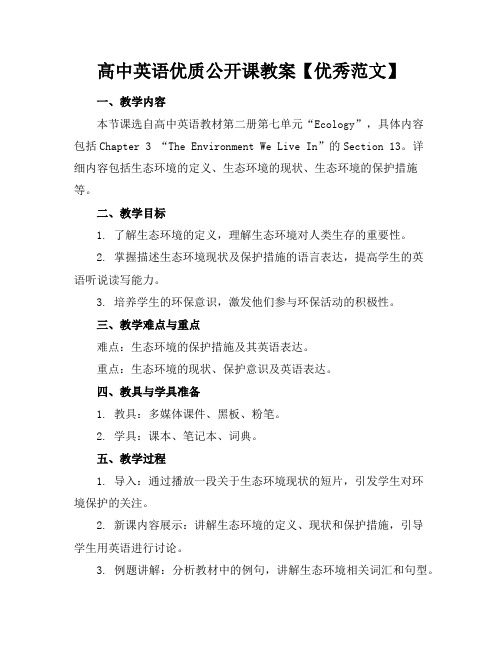
高中英语优质公开课教案【优秀范文】一、教学内容本节课选自高中英语教材第二册第七单元“Ecology”,具体内容包括Chapter 3 “The Environment We Live In”的Section 13。
详细内容包括生态环境的定义、生态环境的现状、生态环境的保护措施等。
二、教学目标1. 了解生态环境的定义,理解生态环境对人类生存的重要性。
2. 掌握描述生态环境现状及保护措施的语言表达,提高学生的英语听说读写能力。
3. 培养学生的环保意识,激发他们参与环保活动的积极性。
三、教学难点与重点难点:生态环境的保护措施及其英语表达。
重点:生态环境的现状、保护意识及英语表达。
四、教具与学具准备1. 教具:多媒体课件、黑板、粉笔。
2. 学具:课本、笔记本、词典。
五、教学过程1. 导入:通过播放一段关于生态环境现状的短片,引发学生对环境保护的关注。
2. 新课内容展示:讲解生态环境的定义、现状和保护措施,引导学生用英语进行讨论。
3. 例题讲解:分析教材中的例句,讲解生态环境相关词汇和句型。
4. 随堂练习:学生进行小组讨论,用所学知识描述生态环境现状和保护措施。
六、板书设计1. 生态环境的定义2. 生态环境的现状3. 生态环境的保护措施4. 相关词汇和句型七、作业设计1. 作业题目:结合教材,用英语写一篇关于生态环境保护的短文。
答案示例:The environment we live in is facing serious problems, such as air pollution, water pollution and the destruction of ecosystems. To protect our environment, we should take measures, such as using renewable energy, reducing waste and planting trees. Only protecting the environment can weensure a better future for ourselves and future generations.答案:生态环境的保护是每个人的责任。
高中英语优秀讲课教案模板范文
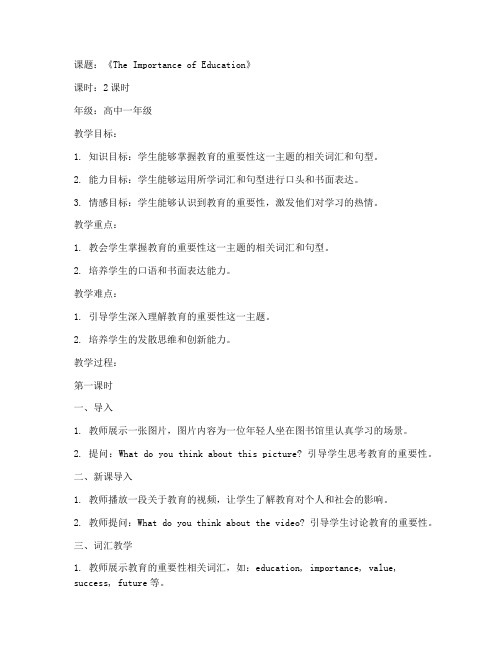
课题:《The Importance of Education》课时:2课时年级:高中一年级教学目标:1. 知识目标:学生能够掌握教育的重要性这一主题的相关词汇和句型。
2. 能力目标:学生能够运用所学词汇和句型进行口头和书面表达。
3. 情感目标:学生能够认识到教育的重要性,激发他们对学习的热情。
教学重点:1. 教会学生掌握教育的重要性这一主题的相关词汇和句型。
2. 培养学生的口语和书面表达能力。
教学难点:1. 引导学生深入理解教育的重要性这一主题。
2. 培养学生的发散思维和创新能力。
教学过程:第一课时一、导入1. 教师展示一张图片,图片内容为一位年轻人坐在图书馆里认真学习的场景。
2. 提问:What do you think about this picture? 引导学生思考教育的重要性。
二、新课导入1. 教师播放一段关于教育的视频,让学生了解教育对个人和社会的影响。
2. 教师提问:What do you think about the video? 引导学生讨论教育的重要性。
三、词汇教学1. 教师展示教育的重要性相关词汇,如:education, importance, value, success, future等。
2. 学生跟读并拼写这些词汇。
3. 教师举例讲解这些词汇的用法。
四、句型教学1. 教师展示关于教育的重要性的句型,如:Education is very important in our life. It is the key to success.2. 学生跟读并模仿这些句型。
3. 教师提问:Can you use these sentence patterns to express the importance of education?五、课堂活动1. 学生分组讨论:What are the advantages of education? What are the disadvantages of education?2. 学生代表发言,分享自己的观点。
高中英语优秀讲课教案模板
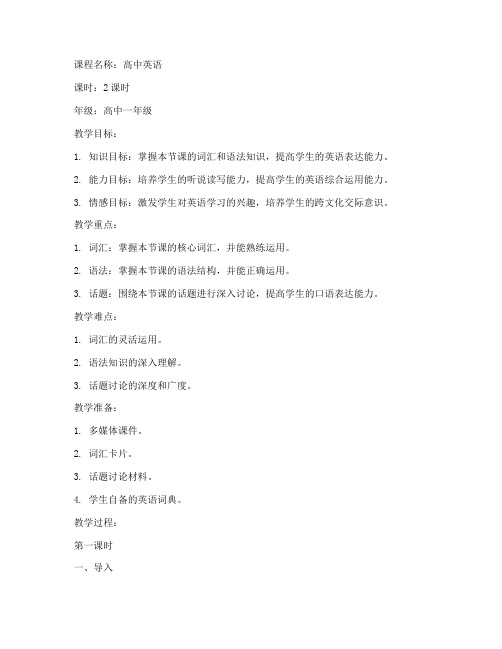
课程名称:高中英语课时:2课时年级:高中一年级教学目标:1. 知识目标:掌握本节课的词汇和语法知识,提高学生的英语表达能力。
2. 能力目标:培养学生的听说读写能力,提高学生的英语综合运用能力。
3. 情感目标:激发学生对英语学习的兴趣,培养学生的跨文化交际意识。
教学重点:1. 词汇:掌握本节课的核心词汇,并能熟练运用。
2. 语法:掌握本节课的语法结构,并能正确运用。
3. 话题:围绕本节课的话题进行深入讨论,提高学生的口语表达能力。
教学难点:1. 词汇的灵活运用。
2. 语法知识的深入理解。
3. 话题讨论的深度和广度。
教学准备:1. 多媒体课件。
2. 词汇卡片。
3. 话题讨论材料。
4. 学生自备的英语词典。
教学过程:第一课时一、导入1. 利用多媒体展示与本节课话题相关的图片或视频,激发学生的学习兴趣。
2. 通过提问,引导学生思考本节课的主题。
二、词汇教学1. 展示词汇卡片,引导学生朗读并拼写。
2. 结合例句,讲解词汇的用法和搭配。
3. 学生进行词汇练习,巩固所学词汇。
三、语法教学1. 利用多媒体展示语法知识点,结合例句讲解。
2. 学生进行语法练习,巩固所学语法知识。
四、话题讨论1. 分组讨论,围绕本节课的话题展开讨论。
2. 邀请学生代表进行小组展示,其他学生进行评价。
五、总结1. 总结本节课所学内容,强调重点和难点。
2. 布置课后作业,巩固所学知识。
第二课时一、复习1. 利用多媒体展示本节课的核心词汇和语法知识点,引导学生复习。
2. 学生进行自我检测,巩固所学知识。
二、拓展阅读1. 分发与本节课话题相关的阅读材料,引导学生阅读。
2. 学生分组讨论阅读材料,分享自己的理解和感受。
三、写作训练1. 针对本节课的话题,布置写作任务。
2. 学生进行写作练习,教师进行个别指导。
四、总结1. 总结本节课所学内容,强调重点和难点。
2. 布置课后作业,巩固所学知识。
教学反思:本节课通过多种教学手段,如多媒体、词汇卡片、话题讨论等,激发了学生的学习兴趣,提高了学生的英语综合运用能力。
- 1、下载文档前请自行甄别文档内容的完整性,平台不提供额外的编辑、内容补充、找答案等附加服务。
- 2、"仅部分预览"的文档,不可在线预览部分如存在完整性等问题,可反馈申请退款(可完整预览的文档不适用该条件!)。
- 3、如文档侵犯您的权益,请联系客服反馈,我们会尽快为您处理(人工客服工作时间:9:00-18:30)。
高中英语公开课教学
设计
高中英语公开课教学设计
Module 5 Ethnic Culture
Period 1 Warming up & Speaking
一、教材简析和教材处理:
Module 5 Ethnic Culture 是高中英语选修7的一个有关民族文化学习的模块。
本模块共分为7个课时。
我大胆地将本模块的教学进行了新的整和,将本模块最前面的Introduction部分和后面的Everyday English and Speaking Function 部分结合为一个课时。
让学生在说的基础上,加深对云南的了解。
同时引入相关的词汇及常用句型,通过说也强化的对词汇的记忆和句型的应用。
本节课以培养说能力为主。
二、教学目标:
理论依据:《高中英语课程标准》
(一)语言知识目标:
1、词汇:border province diverse capital ethnic
minority rainforest bright-coloured costume
silver belt
2、句子:What are (the local people) like?
Tell me more.
Go on.
This is fascinated.
How come?
Doesn’t it (get very hot in summer)?
I’d love to hear more about (the houses).
What about…?
(二)听、说技能与信息能力目标:
能听懂、会说相关话题;能理解表格的主旨;能提取、筛选所学的信息;利用上、下句子猜测新的词汇。
(三)多元能力发展目标:
培养、发展学生的语言能力,逻辑思维能力,观察能力和人际之间的合作能力。
(四)学习策略目标:
在观察,听,说中,合作式完成任务;发挥想象力,多样化地展示成果。
(五)文化意识和情感态度目标:
了解云南省的状况;增强对自然环境的环保意识和对罕见或濒临灭绝动物的保护意识及宣传工作。
三、教学重点与难点:
重点:了解云南省整体的状况;通过活动培养加强对英语表达能力的训练。
难点:运用所学词汇和句型,围绕主题进行听、说交际能力的训练。
四、教学方法:
根据高中英语新课程标准,及英语教学的理论和实践,以及当前教学改革,课程改革的先进理念,本课采用任务型教学途径,以学生为中心,尽量调动语言和非语言资源开展自主性学习的活动,使合作、探究与独立思考相结合,最大程度地优化学生的学习方式,提高课堂学习的效率。
五、教学过程设计:
Step 1: Lead-in.
1) To show a map of china, then make a question “How many provinces are there in china?”
2) Then to show a map of Yunnan, then make a question “Which province is this map?”
3) To ask students to talk about geographical relationship between Tibet and Yunnan.
设计反思: 这部分是新课的导入,用中国地图导入本课,简洁明了.在三个问题的引导下很快进入了新课的内容.第三个问题非常形象地展现出border这个新词的用法.从而直接导入到新词的学习.
Step 2: Words study:
1) Show the list of new words.
2) Do a exercise of new words (Match English definitions with words )
设计反思: 这部分进行的是本节课新单词的学习,然后通过找出相关的英文解释的练习来巩固所学词汇; 同时为下一部分展现云南的各个方面扫清单词的障碍.
Step 3: Learn Yunnan
1) To learn location, population, and size of Yunnan.
2) To talk about ethnic minorities in Yunnan, then show what 25 ethnic minorities are.
(详细了解云南的地理位置,人口和面积大小)
3) To guess which ethnic minorities these beautiful girls are.(激发兴趣,加深了解)
4) To describe what the Dai woman is wearing in the photo, then make a small speech.
(这是一个穿插在本课的一个小组活动,让学生尝试地来描述人物,为下面的主要活动能够顺利进行做好铺垫)
5) To learn more about Yunnan from natural wonders and Rare animals.
(通过图片,激发兴趣)
6) To make a outline of Yunnan. (归纳,总结)
设计反思: 这部分是知识的输入阶段, 通过图片,表格以及相关的小活动让学生清楚地了解云南; 观察图片把教学内容视觉化,有助于学生对云南的感性认识;小组活动培养了学生的合作精神; 为本节课的重点内容顺利完成做了很好的铺垫.
Step 4: Speak task:
1) Sentences preparation
2) To show the task
3) To show a sample of speaking
设计反思: 这是本课的重点,同时也是难点, 对于学生来说,英语教学中的说是最难的部分.因此,我在前三步做了大量铺垫,让学生有话可说, 化难为简.这样可以很好地帮助学生树立信心. Step 5: Extra Exercise:
Make a research on Hainan island, then compare it with Yunnan.
设计反思: 通过对云南的学习,用所学知识来描述海南的状况,进一步加深学生对自己的家乡了解,从而更加热爱家乡,工作后贡献家乡.。
